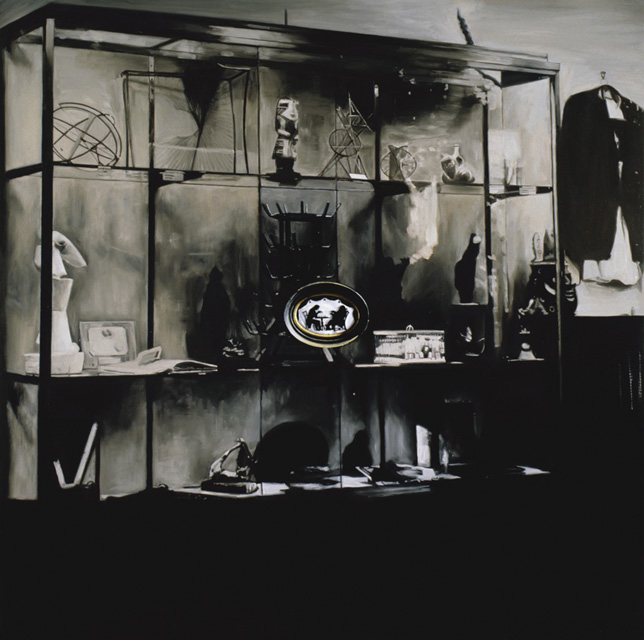


Like a team of obsessive archaeologists, or insatiable scavengers, Lyndell Brown and Charles Green collect and compile both the detritus and the treasures of culture to create a surreal palimpsest of nostalgia. High culture, historical monuments, rare books and personal correspondence are all fodder here, each photograph and painting becoming a kind of memory book or curiosity cabinet. Brown and Green position themselves between the citation of cultural landmarks and achievements, and the inevitable process of these becoming fragmentary and ephemeral when they circulate as fragmented layers of memory and reproduction.
Brown once specialised as a photographer, Green as a painter. The duo commenced their first collaborative painting in 1989. Then in 1995, during a six-month residency at the Power Institute Studio in Paris, they began developing paintings that combined photographic documentation, a painterly aesthetic and a shared fascination with history. Two obsessive minds and distinct aesthetic approaches collided in a bizarre assemblage of cultural bric-a-brac; a labyrinthine game of ideas, textures, objects and treasured junk. Like the Argentinian author Jorge Luis Borges, Brown and Green have become archivists of the uncanny, creators and curators of irrational libraries and systems.
Speaking with a single voice, the artists tell their story: 'We began working on a complex project linking the history of science, the body and colonial discovery, moving from the quotation and deliberate misreading of museum paintings to, more recently, the photographic simulations of non-existent curiosity cabinets'.1 Nothing is safe. Nothing is securely categorised. Here the artists' travels, reading, influences and correspondence collide with history, theory and even love. Their large canvases are peopled with folk from the past. Brown and Green became vivisectors: performing autopsies on the masters; seeking a cause of death; creating canvases full of anonymous limbs, disembodied arms and legs, and fleeting Renaissance figures falling over the edge of the picture plane. Paysage (1994) is almost like the scene of an accident, a painting that is rendered like a badly cropped photograph while still hinting at an earlier integrity.
With Green also active as a critic, their practice is pursued on yet another level: a long-term mission to 'make and write counter-histories, crossing the boundaries ... between criticism and art'.2 Snapshots, pages from The Sunday Times Magazine from London and Le Monde from Paris, postcards, essays torn from magazines, and letters—all become fodder. The European conceptual artists Marina Abramovic and Ulay are there, slapping each other in a 1977 performance, right next to the Mona Lisa, who smiles at their painful performance.
'Fifteenth and sixteenth-century works appear like phantoms in the compositions of Brown/Green,' Merryn Gates has written of these paintings.
Such appropriation is elided with visions of the modern metropolis, with technology and industry ... Their work is not however a mere re-working of the past. It is a struggle to make meaning from our own histories ... It is a discipline through which one can apprehend a state of mind; it is not the surface of history which Brown and Green emulate, but a perception of the historical moment.'z3
Is this post-modern quotation? Certainly, Brown and Green were a product of the Baudrillardian 1980s, when historical citation and collage heralded the waning of the real and the rise of the reproduction. But their work has far more to do with memory; their assemblages are highly personal rather than analytical. For all the slickness of presentation, these are deliberately messy works—messy in the same way that memory works with distorted juxtapositions, messy in the way that a desk or wardrobe becomes chaotic when two busy people share a space. In this regard we are being invited into an intensely personal space; we, like the psychic intruders in the film Being John Malkovich (1999), are offered entrée into the artists' minds, seeing their space through their eyes. Brown and Green's work offers an ultimate voyeurism, the ability to witness the workings of the memory of two minds inextricably linked. Could it be more personal?
- Ashley Crawford
Lyndell Brown and Charles Green are represented in Australia by ARC ONE Gallery, Melbourne.